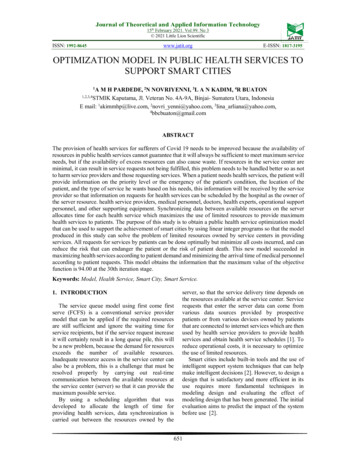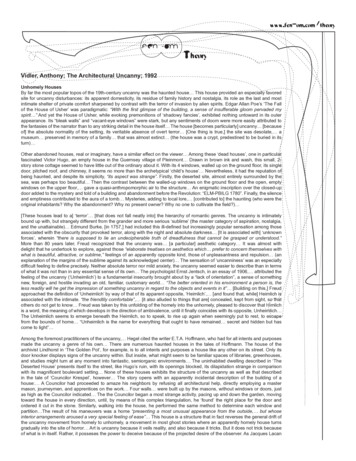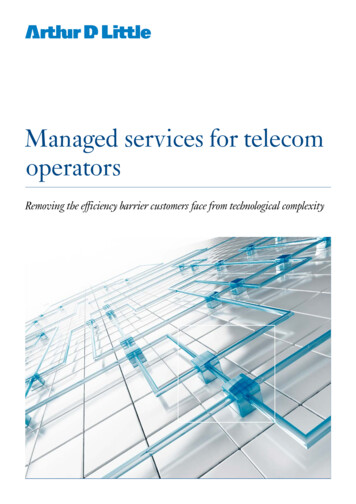
Transcription
Journal of Theoretical and Applied Information Technology15th February 2021. Vol.99. No 3 2021 Little Lion ScientificISSN: 1992-8645www.jatit.orgE-ISSN: 1817-3195OPTIMIZATION MODEL IN PUBLIC HEALTH SERVICES TOSUPPORT SMART CITIES1A M H PARDEDE, 2N NOVRIYENNI, 3L A N KADIM, 4R BUATON1,2,3,4STMIK Kaputama, Jl. Veteran No. 4A-9A, Binjai- Sumatera Utara, IndonesiaE mail: 1akimmhp@live.com, 2novri yenni@yahoo.com, 3lina arliana@yahoo.com,4bbcbuaton@gmail.comABSTRACTThe provision of health services for sufferers of Covid 19 needs to be improved because the availability ofresources in public health services cannot guarantee that it will always be sufficient to meet maximum serviceneeds, but if the availability of excess resources can also cause waste. If resources in the service center areminimal, it can result in service requests not being fulfilled, this problem needs to be handled better so as notto harm service providers and those requesting services. When a patient needs health services, the patient willprovide information on the priority level or the emergency of the patient's condition, the location of thepatient, and the type of service he wants based on his needs, this information will be received by the serviceprovider so that information on requests for health services can be scheduled by the hospital as the owner ofthe server resource. health service providers, medical personnel, doctors, health experts, operational supportpersonnel, and other supporting equipment. Synchronizing data between available resources on the serverallocates time for each health service which maximizes the use of limited resources to provide maximumhealth services to patients. The purpose of this study is to obtain a public health service optimization modelthat can be used to support the achievement of smart cities by using linear integer programs so that the modelproduced in this study can solve the problem of limited resources owned by service centers in providingservices. All requests for services by patients can be done optimally but minimize all costs incurred, and canreduce the risk that can endanger the patient or the risk of patient death. This new model succeeded inmaximizing health services according to patient demand and minimizing the arrival time of medical personnelaccording to patient requests. This model obtains the information that the maximum value of the objectivefunction is 94.00 at the 30th iteration stage.Keywords: Model, Health Service, Smart City, Smart Service.1. INTRODUCTIONThe service queue model using first come firstserve (FCFS) is a conventional service providermodel that can be applied if the required resourcesare still sufficient and ignore the waiting time forservice recipients, but if the service request increaseit will certainly result in a long queue pile, this willbe a new problem, because the demand for resourcesexceeds the number of available resources.Inadequate resource access in the service center canalso be a problem, this is a challenge that must beresolved properly by carrying out real-timecommunication between the available resources atthe service center (server) so that it can provide themaximum possible service.By using a scheduling algorithm that wasdeveloped to allocate the length of time forproviding health services, data synchronization iscarried out between the resources owned by theserver, so that the service delivery time depends onthe resources available at the service center. Servicerequests that enter the server data can come fromvarious data sources provided by prospectivepatients or from various devices owned by patientsthat are connected to internet services which are thenused by health service providers to provide healthservices and obtain health service schedules [1]. Toreduce operational costs, it is necessary to optimizethe use of limited resources.Smart cities include built-in tools and the use ofintelligent support system techniques that can helpmake intelligent decisions [2]. However, to design adesign that is satisfactory and more efficient in itsuse requires more fundamental techniques inmodeling design and evaluating the effect ofmodeling design that has been generated. The initialevaluation aims to predict the impact of the systembefore use [2].651
Journal of Theoretical and Applied Information Technology15th February 2021. Vol.99. No 3 2021 Little Lion ScientificISSN: 1992-8645www.jatit.orgExchanging information on health services can bedone through the use of information technology toprovide health care services and patient monitoring.Smart HealthCare is growing rapidly in solvinghealth care problems, due to an increase in servicedemand to improve the accessibility of care outsidehospitals, as well as the Coronavirus disease(COVID-19) pandemic incident at the end of 2019which led to an increase in demand for healthservices and the need for increased resourceefficiency available [3].If the population growth in the elderly continuesto increase or there is a pandemic event, there will bea shortage of clinical personnel in providing healthservices. The handling of problems that may occurneeds to be resolved quickly and as best as possiblein order to provide better and optimal services topeople who need health services, this reflects thathumans want to always be in a healthy state and havea longer life [4].Health services to patients must be carried outoptimally, so that health services become smart,namely by providing quality services and reducingthe cost of health services and overcoming theproblem of limited nursing personnel [5].In general,the need for health services is increasing from timeto time, because population growth is also increasingthroughout the country [6], and relations betweencountries also seem to be closer and faster, becausethey can be attached by plane, so there arepossibilities that patients can just come from anothercountry. [7]. Improving service to patients bybuilding or adding medical facilities that are not asneeded can result in suboptimal service provision forpatients, and result in the waste of money forinvestors. The resource management departmentoften argues that they have to add less equipment,even though this is a waste as a result of mismatchingneeds that should be met [8].Improving the patient care process is one way toimprove health services. The efficient serviceprocess can be improved by providing qualityservices by utilizing the available resources. A smarthospital environment can facilitate all patientrequests by improving patient care processesthrough efficient scheduling policies and utilizationof health resources through optimal capacityplanning. Discussion of dynamic scheduling policiesto improve patient care processes is carried out withan efficient capacity scheme based on patient flowvariables or patient care processing time. Optimizedscheduling policies and capacity schemes can bebuilt in a smart hospital environment via a wirelesssensor network and a smart health care system [2].E-ISSN: 1817-3195The increasing demand for healthcare in hospitalsis a formidable challenge for managers dealing withthe field of resources, especially in terms of decisionmaking. The challenge is due to services that causehigh costs, limited budgets, and limited resources.Most of the hospitals are experiencing pressure inthe provision of resources, such as a lack of qualifiednursing professionals (doctors and medicalpersonnel), limited hospital equipment and facilities,which can result in increased operating costs.Capacity planning, especially for hospitals, isconcerned with ensuring a balance between thequality of health care provided and the costs ofproviding health care [7], the assignment model isheld to minimize reassignment costs, fees due toservice delays and overtime costs for serviceproviders, additional services are added as limits setat certain operational limits. When a new patient isassigned to be treated in the service department,several other patients will queue and be delayed toget service because the workload in each healthservice is still providing services. [9].Smart health care is a hospital service system tomeet the demands of patients who need healthservices that can be served by the hospital (resourceprovider server) quickly by providing services topatients who need health services, providing servicesto medical personnel based on the type of illness thepatient is suffering from, providing the necessaryequipment according to the patient's disease,providing services by minimizing all costs incurredfor health care and maximizing the use of all limitedresources.The widespread application of electronic healthrecords (EHRs) to record data routinely generated aspart of standards of care provides new opportunitiesfor leveraging this information for qualityimprovement and evidence-based treatment.However, a continuing challenge is how toeffectively implement this high dimensional andunstructured data set [10].To optimize the workflow or clinical care processby considering the fit of a new patient case withappropriate diagnostic expertise to a ClinicalDecision Support System (CDSS), expert expertisemay be recommended to treat similar types of cases.In current clinical practice, patients are referred toexperts based on one or more of the followingfactors: patient preference signs and symptoms,primary care patient or doctor, insurance plan, andavailability of physicians and available medicalequipment. The research framework is developedwith associated methods and algorithms that use thepatient's semantic knowledge to assess and652
Journal of Theoretical and Applied Information Technology15th February 2021. Vol.99. No 3 2021 Little Lion ScientificISSN: 1992-8645www.jatit.orgrecommend expertise with the aim of optimizing theprocess for diagnosing patients [10].A context-adaptive medical diagnosis systemselected from a pool of human experts and the CDSSto make diagnostic recommendations. The systemcan be performed online, and experts are relied onwhen making diagnostic recommendations, with thebest context-adaptive expert accuracy, meaning thebest diagnosis mechanism (whether a human expertor CDSS) for each context is perfectly literate. Inaddition, the diagnostic recommendations made bythe system will be checked by a clinician before finalpredictions are made [10].In hospitals, capacity planning is concerned withensuring a balance between the quality of health careprovided and the costs paid by patients, but highcosts do not necessarily mean optimal service.Planning involves predicting the quantity andspecific attributes of resources required to providehealth care services at a given level of cost andquality. The most basic measurement of hospitalcapacity planning is the number of inpatient bedsavailable, the number of doctors according to theirexpertise and the number of nurses or medicalpersonnel. In general, the capacity model is intendedto calculate the number of nurses needed, while theideal capacity model also provides insight intoopportunities for increased capacity utilization [11].Modeling and simulation are important tools inresolving epidemic disease outbreaks (diseaseoutbreaks in certain communities / areas that exceednormal or normal numbers) that occur suddenly,such as an example of the current case, namely howto handle the COVID 19 pandemic so that it can beinformed and it is understood how the epidemic isspread in the community, several models areproposed and studied. To solve the problem ofepidemic spread in social networks by building andanalyzing the nature of small world networks ormicro-scale social networks [12]. Social networks,family groups, neighbors, the circle of friends, andhealth care systems are classic examples of key rolesin human activities and lives, modeling palliativecare networks as a special type of health care systemusing an agent-based approach, this smart servicemodel provides a framework for studying variousaspects of the system from both perspectives thatfocus on improving the quality of life of patientswith life-threatening diseases or those that can leadto death, handling this problem is done by providingvarious support services to patients so that patientsare more active and comfortable in living everydaylife [13].Repairing network connections is the first steptowards smarter healthcare, and can be done with aE-ISSN: 1817-3195faster and more detailed analysis. This means givingindividuals the opportunity to have more patientinformation so that every professional has access toall relevant information and can make the rightdiagnosis and treatment decisions as quickly aspossible. This is a shift in activity over the yearsfrom notes to the paper, reducing medical errors, andincreasing efficiency, and that means applyingadvanced analysis to large amounts of health data, tosupport better outcomes for smart health care forpeople. The problem with this decision is tocoordinate the use of multiple resources within thehospital [14]. In this case, the most appropriatemodel to build is a linear integer programmingproblem.The purpose of this study is to obtain a SmartHealth model in public health services by usinglinear integer programming so that the resultingmodel can solve problems to provide services asearly as possible by minimizing travel costs,minimum service fees, minimum doctor's fees,minimum priority fees. service and minimize costsdue to inaccurate service delivery time, andmaximize service to patient requests.2. MATERIAL AND METHODThe ratio of the health worker to patientpopulation is imbalanced, due to a lack of health careproviders and inadequate infrastructure [15], thisproblem will be more frequent in rural areas. Variousparameters received from sensors installed inpatients are collected and evaluated through smartdevices [16]. Furthermore, the android application ofthe system displays data about the patient's vitalstatistics without the patient's physical presence[17]. Every time there is an abnormal data change, anotification will automatically appear in the doctor'sandroid mobile application [18]. Therefore, the IoTbased smart health care monitoring system allowsremote monitoring of patients who support smarthospital services [18].Smart cities rely heavily on real-time information,namely sensors to view parameters such astemperature, humidity, allergens, pollution, trafficconditions, and grid status. The values of theseparameters provide context that helps the system tounderstand the state of citizens at a given time [19].Responding to sensory data strategically helps healthcare become smarter [20].The results of the design of this model willprovide a better decision support system in handlingmedical problems in patients, so that patients can653
Journal of Theoretical and Applied Information Technology15th February 2021. Vol.99. No 3 2021 Little Lion ScientificISSN: 1992-8645www.jatit.orgquickly get first aid and what actions to take. Smarthealth care starts with the input of patient data or datareceived from a device that is installed by the patientor what is called a smart device attached to thepatient, the data will be received by the server thathandles the distribution of patient services, if thepatient is the first priority, the patient must be servedimmediately. and prioritized at the nearest connectedhospital. to the server system, and in this condition itis also recommended to immediately pick up thepatient, and maybe the patient can be escorted by thepatient's family or closest person is also possiblebecause in this case, the first priority is to take firstaid to the patient. Furthermore, the distribution ofpatient care which is priority 2 will be provided byhospital services depending on the decisions that willbe given by the system, where the considerations inthe assessment are the availability of resources at thehospital, the availability of specialist doctors whohandle diseases or the availability of polyclinics, theavailability of supporting equipment. required andthe availability of inpatient rooms which provideinformation about the type/class of room. Thefollowing provides a framework for the design of adecision support system model for smart health care[21].Policies in providing health services will be verybeneficial if used wisely and can help many people.As health facilities develop, they will provideservices in an emergency, which if it occurs will alertthe nearest resource or facilities to the location of thevictim. [22].E-ISSN: 1817-3195Table 1: The function states the cost of h medical stafftravel from place i to the j place to provide healthservices to patientsDescription: Costs for h medical staff travel in unitsof 10,000 rupiah. The table above explains the travelcosts of medical staff h from αij (i 1, j 1) worth 40.000, travel costs of h medical staff from αij (i 1, j 2) worth 10.000, travel costs of h medicalstaff from αij (i 1, j 3) worth 50.000, travel costsof h medical staff from αij (i 1, j 4) worth 80.000, travel costs of h medical staff from αij (i 1,j 5) worth 20.000, travel costs of h medical stafffrom αij (i 2, j 1) worth 40.000, travel costs ofh medical staff from αij (i 2, j 2) worth 30.000,travel costs of h medical staff from αij (i 2, j 3)worth 20.000, travel costs of h medical staff fromαij (i 2, j 4) worth 100.000, travel costs of hmedical staff from αij (i 2, j 5) worth 20.000,and so on.Table 2:Tthe function states the travel cost of the type ofmedical service k from place i to place j for the provisionof health services to patients3. DATA COLLECTIONThe data source for benchmarking (a processcommonly used in management or generallystrategic management) in this study is medical datain the health sector in hospitals and health offices.The numerical data obtained is entered into a matrixform which is used as a support in the developmentand modeling process by providing clarity on eachobjective function of the model mathematically.The limitation in this study only discusses the costof priority level of service, travel costs for types ofmedical services, travel costs for medical personnel,costs for medical personnel, fees for doctors, fees fortypes of services, time required for medical staff.This data is taken from the minimum function matrixset, and is presented in detail in the table below:Description: The cost of travel for the type ofmedical service k in units of 10,000 rupiah. The tableabove explains the cost of travel based on the type ofmedical service k from αij (i 1, j 1) worth 30.000, travel costs based on the type of medicalservice k from αij (i 1, j 2) worth 60.000, travelcosts based on the type of medical service k from αij(i 1, j 3) worth 60.000, travel costs based onthe type of medical service k from αij (i 1, j 4)worth 60.000, travel costs based on the type ofmedical service k from αij (i 1, j 5) worth 100.000, travel costs based on the type of medicalservice k from αij (i 2, j 1) worth 100.000, travelcosts based on the type of medical service k from αij(i 2, j 2) worth 70.000, travel costs based on654
Journal of Theoretical and Applied Information Technology15th February 2021. Vol.99. No 3 2021 Little Lion ScientificISSN: 1992-8645www.jatit.orgthe type of medical service k from αij (i 2, j 3)worth 60.000, travel costs based on the type ofmedical service k from αij (i 2, j 4) worth 100.000, travel costs based on the type of medicalservice k from αij (i 2, j 5) worth 60.000, andso on.doctor honorarium d from ij (i 2, j 3) worth 40.000, doctor honorarium d from ij (i 2, j 4)worth 60.000, doctor honorarium d from ij (i 2,j 5) worth 40.000, and so on.Table 5: The function states the fee for the type of serviceto k from place i to place j for the provision of healthservices to patientsTable 3: The function states the honorarium of medicalstaff h from place i to place j for
E mail: 1akimmhp@live.com, 2novri_yenni@yahoo.com, 3lina_arliana@yahoo.com, 4bbcbuaton@gmail.com ABSTRACT The provision of health services for sufferers of Covid 19 needs to be improved because the availability of resources in public health services cannot guarantee that it will always be sufficient to meet maximum service











